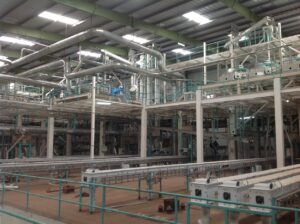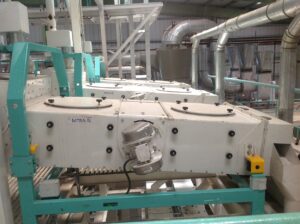Highlighting the efficiency of steel in industrial structures is this Pulse Processing Unit in Maharashtra. With a whopping 1800 MT steel used, the project spreads across 12 acres. Hitesh Vora, Founder & Principal, Vyom Consultants, dives into the details of the unit and spotlights the design challenges and its innovative solutions.

Spread across a 12 acre land in Khopoli, Maharashtra, this 500 tonne per day (TPD) Pulse Processing Unit houses two fully automated pulse processing plants – A 300 TPD pigeon pea processing plant and a 200 TPD black gram processing plant. The unit belongs to ETG (Export Trading Group, Africa), a global giant in IMP-EX of agro products.
|
The facility houses:
|
 Crafting Possibilities
Crafting Possibilities
Elaborating on the design brief from the client, Hitesh Vora, Founder & Principal, Vyom Consultants, shares, “RCC design, in general, takes more time during execution. The client’s requirement was the plant should be operational within 2.5 years and hence the design philosophy had to be changed to expedite the onsite work. So, we decided to construct the plant in steel.” To reduce the overall project costs, he adds that Concrete Filled Tubes (CFT) and Plate Girders were used.
The site itself was a partial hill and partial valley which needed cutting-filling activity leading to a non-uniform SBC across the entire site. Adding to that, a large volume of cabling and aspiration piping/ducting goes through the plant which makes the use of bracing structure difficult. “The milling process itself, an essential component of the plant’s operations, spans over 10 days. Fresh material is introduced into the process daily, so a substantial 5,000 tonne of material remains within the plant on any given day. This necessitated that we take meticulous consideration of dead load in the design.” Vora says, “There are many machines that vibrate heavily and have to be checked for resonance with the structure. So a dynamic analysis was also required.”
Placing an emphasis on the selection of the right materials, he adds, “The structural members were selected to be easily available in the market and its shape provided the flexibility for easy assembly and installation of process machinery and units. Nearly 320 hoppers and 1,000+ bin walls had to be identical in shape and size so that they can be installed easily and speed up assembly.”
Innovative Structural Approach
The site’s rugged terrain posed significant challenges, including the presence of rocks in 70 per cent of the area, necessitating controlled blasting. Additionally, valleys required filling, resulting in a non-uniform Soil Bearing Capacity (SBC) across the site. To tackle this, Vora reveals that the company adopted a tailored foundation approach for each structure, meticulously aligned with the base soil characteristics and SBC.
The project encompassed numerous bins and hoppers distributed throughout each bay. He adds, “If the structural system were designed using I and C-sections, the assembly of the bins and hoppers would have required varying designs of the same considering the mounting pattern on I and C sections.” Opting for square sections instead enabled a consistent mounting pattern for the bins and hoppers, simplifying and expediting their assembly.
Vora further reveals that in order to avoid clashing and reduce interference with cabling and ducting, the bracing was localised. The connections were arranged in a manner that required minimum bracing to resist lateral load. “On one side of the beams, we made use of moment connections and on the other pin connections. So, this allowed for localising the bracing in the same direction as the beam and allowing clear space for cabling and ducting on the other side of the beam.”
The assembly requirements for the bins and hoppers posed another challenge. “It became necessary to go for square sections. The availability of sizes of square sections in the market was limited and the built-up sections were not feasible due to the stringent project timeline.” He adds, “On the other hand, the dead load of 5000 MT of material in the process was a critical factor in the design. The available sections did not suffice the dead load criterion.” Innovatively, CFTs were tried and found sufficient for the design loading criterion.
Setting up
The core of the processing unit relies on the impeccable performance of the sortex machines, demanding an environment completely devoid of vibrations for optimal efficiency. Ingeniously, the design surmounted this challenge by suspending these machines directly from the ground, elevating them 6 m above without any physical connection to adjacent structures. This innovative solution ensured the ideal operational conditions.
Moreover, the facility bears a substantial load on the first floor, primarily due to the presence of bins. Achieving the necessary equilibrium between the structural stiffness and the centre of gravity necessitated a series of design iterations. Vora says, “Through these iterations, we fine-tuned the arrangement and placement of the bins. The finalised positions were meticulously chosen, aligning seamlessly with the structural requirements.”
The setup of the complete facility included extensive onsite works, installations and execution from multiple agencies. Talking about the stakeholders involved in the plant, “The entire processing machinery was from Buhler, Switzerland; dryers were from South Korea; silos were from the USA. Other materials such as conveyors, elevators, electrification, aspiration and ducting were locally procured.” Vora says, “In such a scenario, the structure needed to be flexible enough to account for the installation of various machines. This flexibility would be difficult to achieve with an RCC structure.”
 Tech toolkit
Tech toolkit
Since the design aspects needed a lot of iterations, analysis and design using STAAD reduced the time to a great extent. The detailed engineering was done using STAAD in just two and a half months with over 45 iterations done to arrive at beam/column sizes and bin arrangements.
Smart savings
The introduction of concrete-filled tubes (CFT) instead of a pure steel structure led to a reduction of 260 MT in column steel. Ingeniously integrating 3 mm bin walls as structural elements allowed a downsizing of the mounting section from ISMB 600 to ISMB 450, yielding 113 MT of steel savings. These design choices collectively translated to a total savings of Rs 33.5 million.
Notably, this efficiency extended to ancillary components as well, with custom-made grating designs utilising pipes slashing an impressive 488 MT of steel and saving Rs 43.9 million. Even in foundational aspects, the project demonstrated resource consciousness, saving Rs 20 million in earthwork and foundation design.
Vora shares, “At the execution of the project, an impressive 861 MT of steel was conserved and Rs 97.4 million in project costs. Through the usage of steel, the project, which was originally slated for a 30-month duration, was successfully brought to completion in a mere 21 months.”
The sustainable way
The comprehensive facility design boasts a seamless integration of rainwater harvesting capabilities. Positioned in a region characterised by intense monsoon rains, this approach not only capitalises on the abundant rainfall but also reaps substantial benefits. Diligent planning extends to the plant layout, which was thoughtfully crafted to minimise disruption to the natural vegetation. Beyond design considerations, during the construction phase, a workforce of 300 individuals from the vicinity was employed. Vora says, “As the facility transitioned into operational status, this commitment persisted, with 250 local individuals securing employment.”
Fact file
- Project: Pulse Processing Unit
- Location: Khopoli, Maharashtra
- Client: Export Trading Group, Africa
- Architect & Consultant: Vyom Consultants
- Tonnage: 1,800 MT



 Crafting Possibilities
Crafting Possibilities

 Tech toolkit
Tech toolkit

